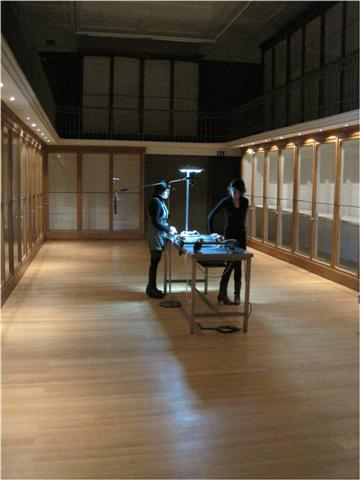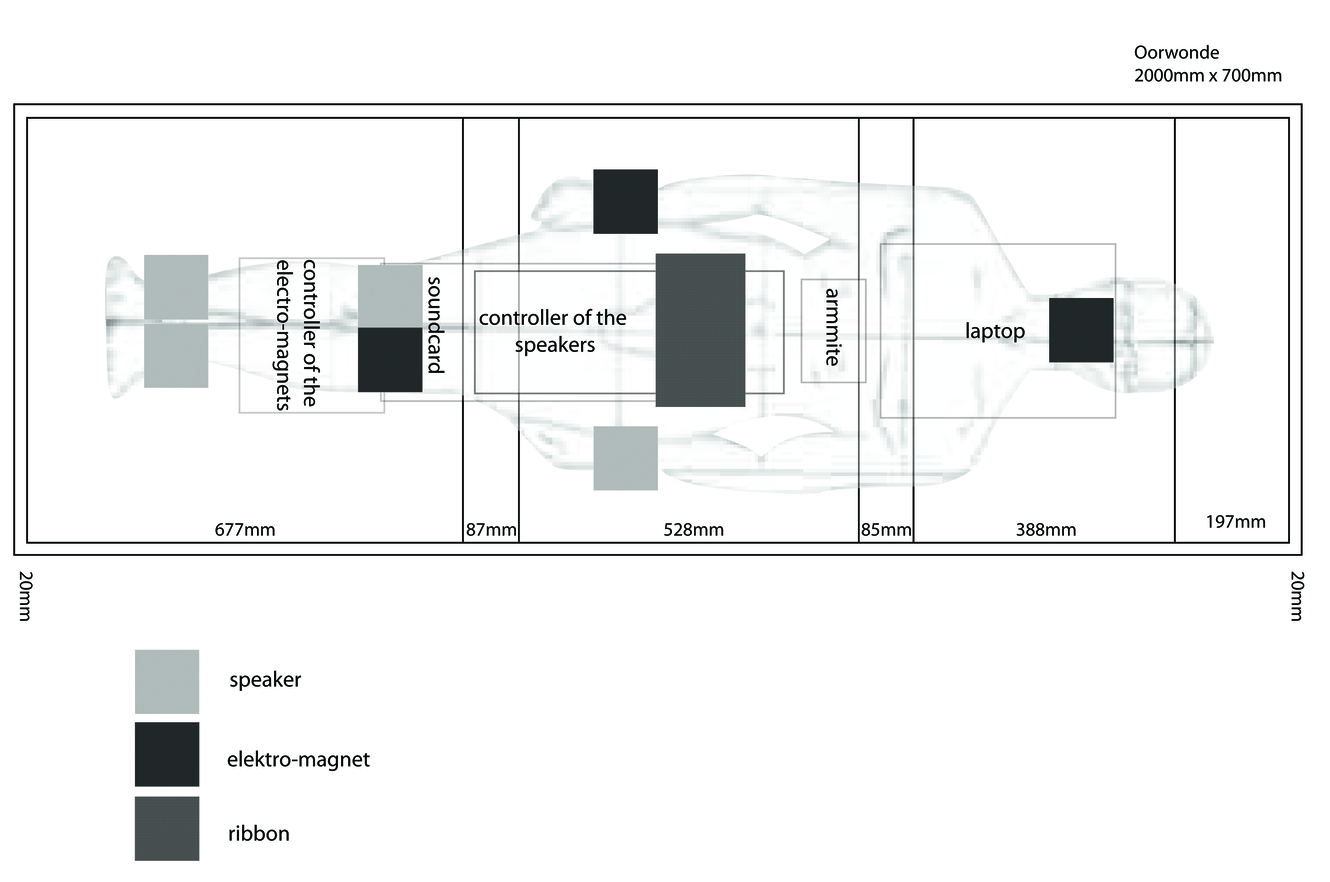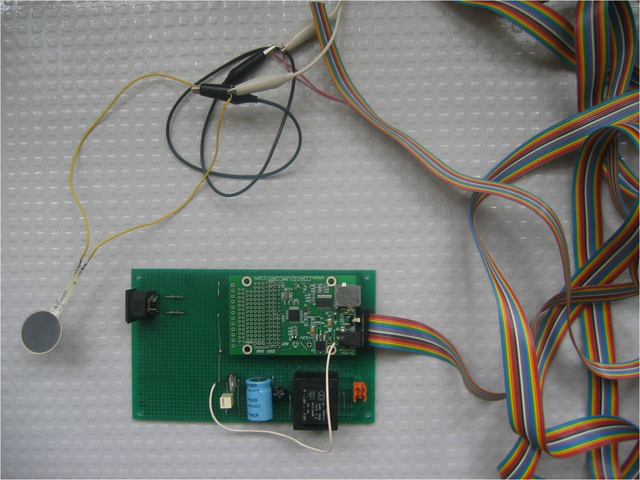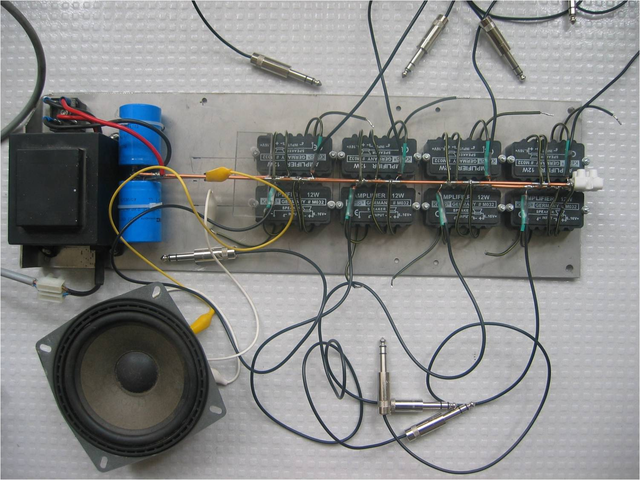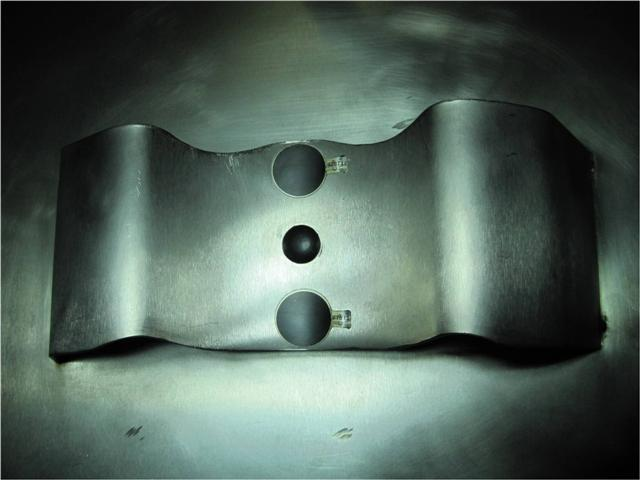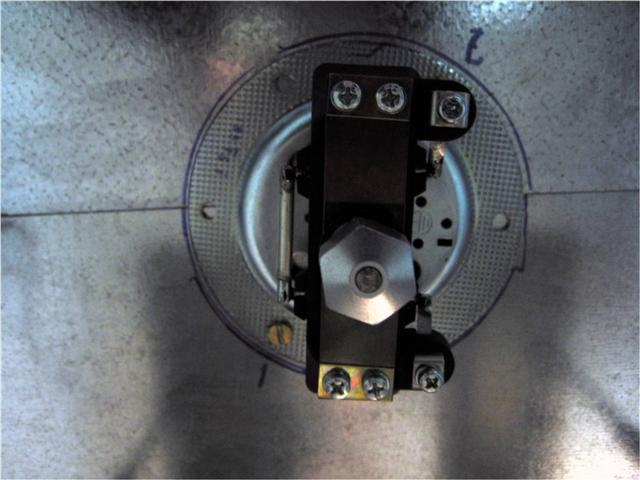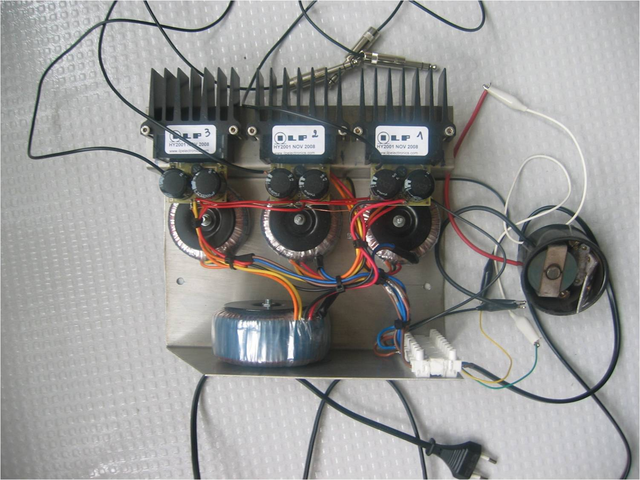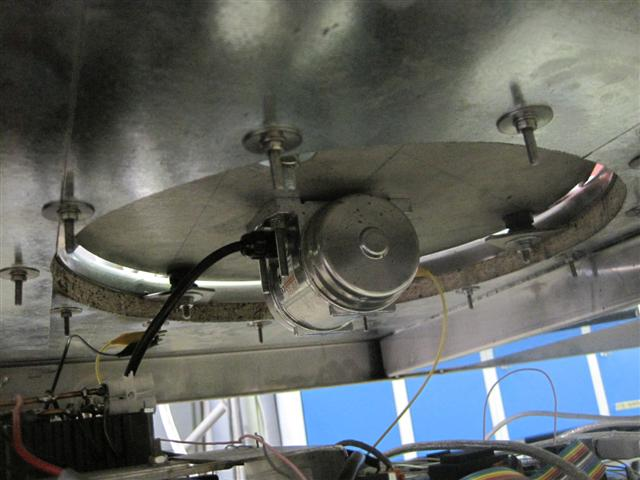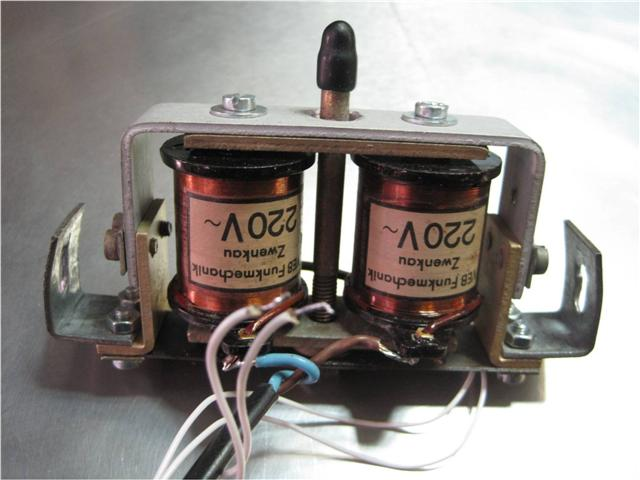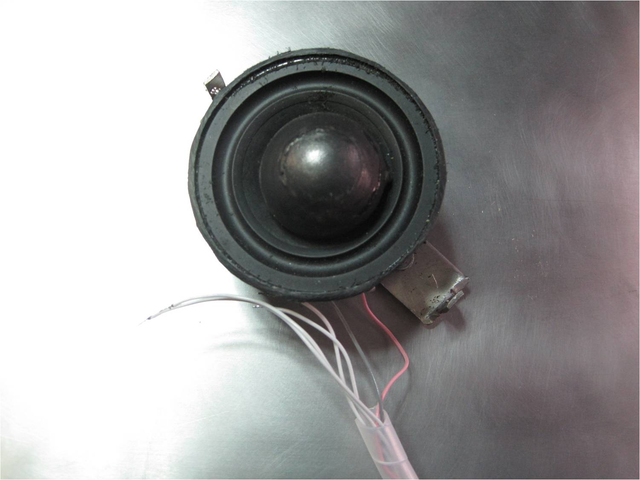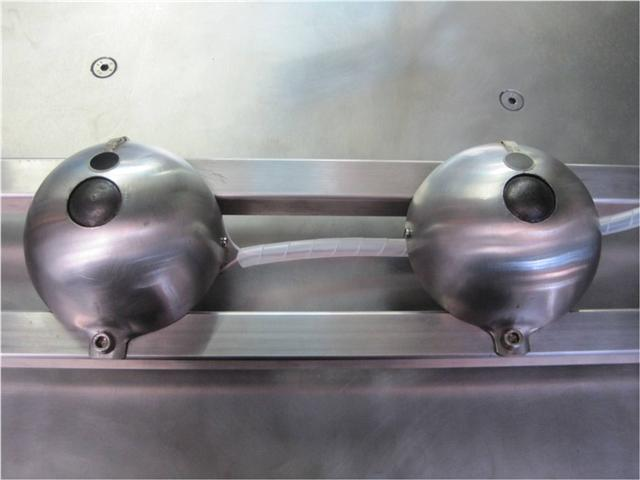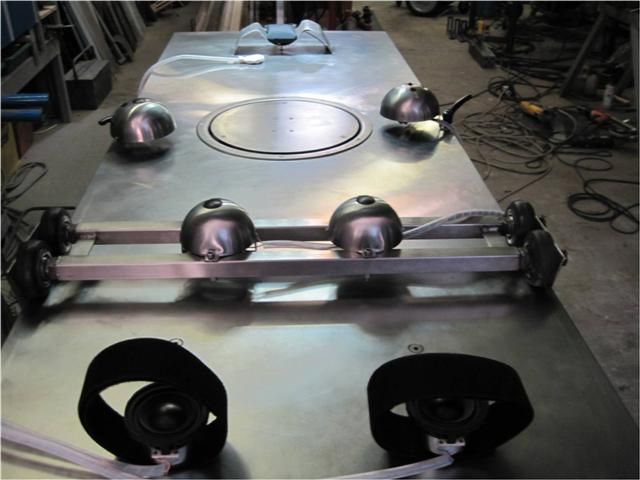The concept of Oorwonde is an aural surgery whereby the visitor, aka the “patient”, hears and feels the soundtrack of a fictitious operation. The patient can influence various aspects of the sounds and determine the location where the sounds are reproduced.
Oorwonde’s focal point is to bring across sounds that balance on the border of the audible. To achieve this the sounds are conveyed in various ways; speakers, electro-magnets, a vibrator motor and a piezoelectric disk are assigned to specific places on the human body. Oorwonde further explores the concept of bodily hearing as the various elements are aimed at different body parts. Hearing is no longer restricted to the ears.
Oorwonde is as much a tactile experience as an auditory one as the emitted sound waves are designed to be felt. When standing next to the table the produced sounds can barely be heard. Consequently, Oorwonde can only be fully experienced when its surroundings are completely silent. Noise from works nearby would completely destroy the patient’s experience of the subtle noises and feelings.
The visual shape of Oorwonde reflects the surgical associations. The table is constructed in stainless steel and the lamp producing a clear-cut bundle of white light on the patients face resembles an operating lamp.
Although at first sight the sound work might strike someone with terror and often people are hesitant to take place on the table, the actual experience is a rather pleasant one as in contrast to a real operation it is the patient who is in full control.
The concept of Oorwonde is an aural surgery in which the visitor, aka the ‘patient’, hears and feels the soundtrack of a fictitious operation. The patient can influence various aspects of the sounds and determine the location where the sounds are reproduced.
Oorwonde's focal point is to convey sounds that balance on the border of the audible. To achieve this the sounds are transmitted in various ways; speakers, electro-magnets, a vibrator motor and a piezoelectric disk are assigned to specific places on the human body. Oorwonde further explores the concept of bodily hearing as the various elements are aimed at different body parts. Hearing is no longer restricted to the ears.
Oorwonde is as much a tactile experience as an auditory one as the sound waves emitted are designed to be felt. When standing next to the table the sounds produced can barely be heard. Consequently, Oorwonde can only be fully experienced when its surroundings are completely silent. Noise from works nearby would completely destroy the patient's experience of the subtle noises and sensations.
The visual shape of Oorwonde reflects its surgical associations. The table is constructed in stainless steel and the lamp producing a clear-cut bundle of white light on the patient's face resembles an operating lamp.
Although at first sight the sound work might induce feelings of terror, and people are often hesitant to take place on the table, the actual experience is a rather pleasant one as in contrast to a real operation, it is the patient who is in full control.
The core of Oorwonde is a stainless steel table of the type used in industrial kitchens and for post-mortem examinations. The reason for this material is twofold. The stainless steel evokes a cool and icy feeling and conveys the medical association, but besides an aesthetic benefit it also has a technical advantage. Stainless steel is very durable and does not rust. Notwithstanding the very thin steel utilized (< 1 mm), it is possible to weld extensions onto it.
Underneath the table four bolts hold up two strips of steel that carry all the steering equipment: an 8-channel soundcard, a laptop, a controller for the electro-magnets, a controller for the speakers, a controller for the vibrator motor and an ARMmite microcontroller.
Nine sound-producing elements were integrated into specific places in and on the table: the neck, the mouth, the buttocks, the palm of both hands, the hollow of both knees and the cavity of both feet. Their location was chosen on the basis of two things: the sensitivity of the human body and the places with the highest probability of bodily contact.
To suit people of various heights several of the sound-producing elements are moveable. The contact points for the knees are attached to a sliding system and the contact points for the hands can turn 180 degrees. When measuring people's dimensions, I noticed great variation in the distance between the middle of the neck and the tailbone. Consequently, the contact point at the buttocks had to be larger. After an experiment with a subwoofer that proved to be too fragile, a vibrator motor attached to a circular plate integrated into the table turned out to be an appropriate solution to cover a larger surface.
Electro-magnets, recycled from old signal-horns, were used for the left hand, the left knee and the neck element. The electro-magnet integrated into the left knee element is of a different type to the electro-magnets at the neck and left hand and therefore gives a different sensation. The vibrations of the electro-magnets are transmitted through molded rubber shapes. The electro-magnets at the left hand and left knee elements are incorporated into stainless steel soup spoons. A neck support was welded onto the table and comprises the neck element.
The right hand, right knee and both foot elements make use of a speaker to convey vibrations. Both the right hand and the right knee elements are incorporated into a stainless steel soup spoon. For each foot element a speaker is glued into a velcro strap. The speakers are extended with a rubber form to transfer the movements of the cone to the body.
The mouth-piece uses a piezoelectric disc cast in silicone. As this element makes use of bone conduction, the user has to place his or her teeth onto the silicone disc to hear what is emitted. A fresh balloon is placed over the silicone shape for each new patient.
Oorwonde is a very intimate experience where everything is focused on hearing and feeling. To stimulate this, a very bright lamp comprising 5 x 57 white LEDs is mounted at the head of the table so as to shine directly in the face of the patient who has no other possibility than to close his or her eyes. The light stimulates the patient to concentrate fully on sensing and hearing.
The combination of the simple yet elegant lamp design and the strength of the light produced adds to the medical aura of Oorwonde.
By pushing pressure sensors, the patient can activate one or more of the above elements. The sound and movements change according to the pressure exerted. Two force sensitive resistors (FSRs) are placed in parallel on the neck element to detect pressure. Four FSRs can be found on each hand element. An FSR was placed on each knee element as well. The FSRs are used to detect body contact and to measure the pressure applied.
It was essential for me that the actions of the person lying on the table would not be limited to activating a pre-programmed process, as is often the case with works utilising a motion detector sensor or an on/off button, switch or pedal. Instead, I wanted to provide the visitor with all tools necessary to create a unique composition. Their role is no longer restricted to that of a spectator. A two-way interaction is necessary for the operation of the work. If the visitor is not pressing any FSR, no sounds are emitted. Through pressing the various FSRs the person lying on the table can choose which sound producing sources to activate as each FSR is assigned to one or two specific sound source(s). Changing the pressure on an FSR has an immediate impact on the produced sound. For two elements, the right hand and the left foot, the pressure range is divided into several areas and different pre-recorded sounds are triggered depending on the observed pressure and the according pressure range. For the other elements the pressure measured of the associated FSR is linked to at least one musical parameter. The person lying on the table is inclined to listen, to analyse the effect of his actions and to master the system. The FSRs do not only let the visitor take control of the course of the work but also of his or her perception of the work.
the initial mapping
| neck: 2 sensors |
electro-magnet neck |
| vibrator motor buttocks |
|
| left hand: sensor 1 | electro-magnet left hand |
| left hand: sensor 2 | speaker left foot |
| left knee: sensor | electro-magnet left knee |
| right hand: sensor 1 |
speaker right hand |
| right hand: sensor 2 | speaker right knee |
| right knee: sensor | speaker right foot |
| piezoelectric disc mouth |
As the utilized sound card is limited to eight audio outputs, the same signal is sent to the speaker at the right foot and the piezoelectric disc. To accommodate the different sound volumes of each medium a resistor was placed in series with the speaker of the right foot.
The try-out of Oorwonde at music centre De Bijloke (Ghent, Belgium) in March 2010 revealed that for many people the mapping was too complicated to grasp in fifteen minutes. Therefore two extra FSRs were placed on each hand element in order to control all the elements (except the neck and the buttocks) with the hands. To create a height difference with the surface of the spoon, three FSRs of each hand element were placed on small rubber cushions. This adaptation made it easier for the momentarily blinded user to find the controllers without needing to look.
the current mapping
| neck: 2 sensors |
electro-magnet neck |
| vibrator motor buttocks |
|
| left hand: outer sensor |
electro-magnet left hand |
| left hand: middle sensor |
electro-magnet left knee |
| left hand: inner sensor |
speaker left foot |
| right hand: outer sensor |
speaker right hand |
| right hand: middle sensor |
speaker right knee |
| right knee: inner sensor | speaker right foot |
| piezoelectric disc mouth |
The above mapping was tested at the second try-out of Oorwonde during E-dinges at the Flemish Parliament (Brussels, Belgium) in November 2010 and gave satisfactory results. It was easier to find the sensors blindly and it turned out to be much more intuitive to operate the elements from the hands. The current mapping makes no use of the sensors located on the knees. A simple program change allows one to go back to the initial mapping.
A program in Basic converts the changing voltages from the FSRs into MIDI commands. The MIDI commands are read in Pure Data. The commands either evoke pre-recorded sounds or generate real-time sounds of which various parameters change depending on the pressure exerted.
I wish to thank the University College Ghent for supporting my artistic research financially. Many thanks to Dr. Godfried-Willem Raes (HoGent) for his guidance and among other things, his welding skills.
My deepest gratitude goes to the Logos Foundation, without whom the practical realization of Oorwonde would not have been possible.
Tactile sense is as important as sound for Oorwonde. To create movement, I make use of subsonic sounds. Oorwonde is not the first sound work that makes an appeal to sounds outside the range of human hearing, various other artists have preceded me and explored this field.
The range of human hearing extends from 20 to 20000 Hz. Many sound artists have tried to expand this range through exploring the borders of the audible, either above (ultrasonic) or below (subsonic) human audible range. Whilst we are not able to hear subsonic sounds, they can still form interesting artistic material as we can feel them and they can even be made visible.
In a similar fashion to Oorwonde, the Ultrasound of Therapy from Staalplaat Soundsystem evokes medical associations. This performance integrates works from various artists. Not only the design, but the whole set-up of the Ultrasound of Therapy is based on a hospital admission and treatment. At the start of each performance, the spectator has to fill in an admission form providing various demographic data. On the basis of this data a specific treatment is selected. Every member of the audience is escorted by a performer dressed up as a doctor or nurse to a sleeping cubicle where he or she is asked to lie down on a hospital bed, on a stretcher or in a hammock. The treatments range from acoustic sounds produced by two modulated toy music instruments driven by water power to lying down in an electric field with two magnets placed on each side of the head. For some treatments bass shakers, transducers created to feel low bass sounds, are attached to the bed; other treatments make use of sanding machines mounted underneath the bed or electronically stimulate the muscles of the body of the spectator via adhesive patches. On top of the individual treatments sounds are being reproduced throughout the whole performance space. At the end of the treatment the spectator is asked to write down an evaluation of his or her received treatment. (Staalplaat Soundsystem)
One of the artists cooperating on the Ultrasound of Therapy is Lynn Pook. Pook has created several sound works where speakers are placed directly onto the human body. In à fleur de peau sixteen speakers are hanging from the ceiling. Pook or an assistant tapes the speakers onto the spectator with the aid of velcro. The speakers are spread over the human body: on the back of each foot, in the spaces behind the knee, in the lumbar region, on the back of each hand, at the elbows, on the shoulder blades, at the neck, on the temples and on the forehead. Pook created the sounds on an analogue modular synthesizer combining sine waves, rectangular waves and sawtooth waves. The location and movement of the sound from one body point to another forms the focal point of the ten-minute-long composition. To be able to fully focus on the sounds transmitted over the body, earplugs are provided. (Pook, (1)) In her later projects Pook continues to work with speakers positioned directly onto the body. In Pause, created together with Julien Clauss, the audience has to lie down in hammocks while fourteen speakers scattered over the body produce sounds. (Pook, (2)) Unlike Oorwonde, Pook does not integrate the sound producing element in the hammocks. Instead Pook herself or an assistent place the textile covered speakers on the body of the visitors.
Whilst Pook adds speakers directly onto the body, Kaffe Matthews opts for a similar approach to Oorwonde and integrates loudspeakers into a bed frame and underneath a mattress. Matthews' wooden framed bed breaths the atmosphere of a comfortable bedroom and the medical aura is hard to find. Sonic bed offers space to one or more persons. Matthews’ twelve-channel compositions aim to move the bed and to immerse the listener in a bed of sound, not only directed towards the ear, but towards the whole body. (Matthews, (1)) In a later phase the number of speakers was extended to fourteen instead of twelve. Eight midrange & tweeter speakers were integrated in the side panels of the bed and six subwoofers were located underneath the mattress (Matthews, (2)) Prior to Sonic bed Matthews created an armchair with seven speakers hidden underneath the upholstery. A bench version based on the same concept is permanently installed in Mexico City. (Matthews, (3))
Wendy Jacob did not fail to notice that the sensation of sound opens up possibilities for the hearing disabled. The deaf audience is invited to sit, stand or lie down on a floor-like structure in which several speakers are integrated, to experience the vibrations of the barely audible sound. (Jacobs)
The idea to feel sound is not new, but the invention of audio transducers made it easier for artists to create works based on the sensation of sound. One of the first to give shape to this was Bernhard Leitner. Leitner created several works in which sounds are aimed directly at the human body. For Leitner, listening is not limited to the ears, but is extended to all parts of the body. (Schulz, 2002) He makes use of various interfaces to bring across his idea of bodily hearing. In hand-ton-objekte two objects consisting of a speaker integrated in a plexiglass bowl equipped with a handle were aimed at various parts of the human body. (Leitner, (1)) Following this first experiment Leitner created Ton-Liege, a reworked wooden deck chair with a subwoofer placed at calf height and another subwoofer directed towards the lower back. (Leitner, (2)) Leitner buildt further on this idea in Liege mit 6 Lautsprechern in which he added one speaker at thigh height and attached another speaker at shoulder height. Two extra speakers were incorporated, not in the chair itself, but placed left and right of the chair slightly above ear level. Leitner's idea was to let sound waves move through the body. (Leitner, (3)) Around the same time of Liege mit 6 Lautsprechern he created Ton-Anzug, a body suit with a built-in grid that allowed him to attach loudspeakers to various parts of the body. (Leitner, (4))
Various artists have played with the visualization of subsonic sounds, either through placing items on speakers, positioning speakers underneath liquids or through visualizing air pressure fluctuations.
In Surfaces vibrantes Xavier Charles places small things such as pinecones and crumpled aluminum foil on subwoofers, the installation consisting of various speakers that each have a different item placed on top of them. (Happy New Ears, 2007) When the speaker emits low frequencies, the cone of the speaker moves back and forth at the speed of the produced frequency. The items placed on top of the speakers move up and down, bump into each other and as a result create percussive sounds.
Thomas McIntosh, Mikko Hynninen and Emanuel Madan used a different approach to visualize subsonic sounds in their sound work Ondulation. The low frequency loudspeakers are not covered by various items, but they are located underneath a layer of water. These speakers cannot be seen as they are integrated into a basin and are fully hidden by 2000 liters of whitish colored water. In Ondulation the transmitted bass sounds create 3D-patterns on the surface of the liquid. Theatre lights are projected onto the surface and the patterns in the water are reflected on a projection screen. Sounds are not only emitted via the water covered speakers, but also the movements of the liquid are perfectly adjusted to the sounds reproduced via a surround sound system. The subwoofers, the lights and the surround system form a pre-programmed cycle lasting fifty-six minutes. (Maes, 2008)
Dutch artist Felix Hess takes it one step further as at first sight his installation, It’s in the air, does not seem to have any relation with sound. This collection of small, square flags, manufactured from white rice paper only reveals its meaning when a person enters the same space. Even the smallest turbulence has an influence on the position of the small flags which do not only react to sounds or movements of the visitors, but also to their breathing. When a spectator is standing still for some time all the flags will turn in their direction. The body temperature of the visitor makes the air, surrounding their body, heat and rise up. As a result colder air flows towards them, over the floor, and the small flags turn in their direction. (Kuitenbrouwer, 2003) It’s in the air makes this air-movement visible.
